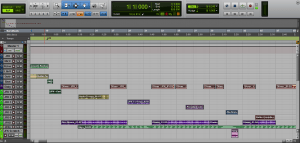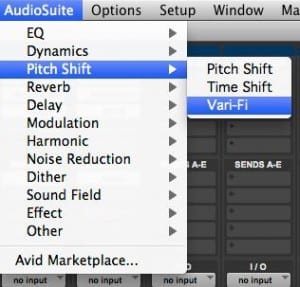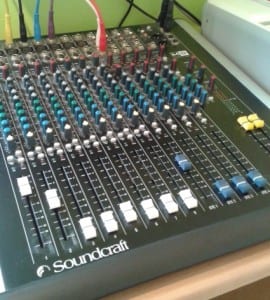The soundscape for my project is now completed and ready for submission and I have decided that the title of my soundscape will be called Freedom due to the subject of the piece. This blog entry will give a breakdown of the soundscape and talk of why I did certain things the way I did in the track.
Intro: 0:00-0:43
The beginning of the track briefly introduces the four main individuals that are involved in the soundscape (JFK, Malcolm X, George Lincoln Rockwell and Martin Luther King, Jr.) with The Star Spangled Banner being played on guitar behind the different parts. I wanted the guitar part to sound bad and out of tune so I stretched the clip using elastic audio in pro tools, this was to reflect on how much of a mess America was in during the 1960s in regards to the civil rights situation. As the intro comes to a close the audio is slowed down at which point a gunshot is heard, this was done to highlight how all the individuals involved were assassinated during the civil rights movement.
The JFK Movement: 0:44-2:30
The soundscape bases itself on the four individuals and is told in chronological order of the year in which each was assassinated and so John F. Kennedy was to be the first movement. The part starts with the audio taken from Kennedy’s election campaign and the into a drum and keyboard part in which the narration sits on. The drum part was a four bar sample I found on the internet but I cut up the parts and changed it to sound how I wanted, the keyboard was created using a plug-in on my computer with basic chords of a minor key. The use of the minor key was made throughout my whole soundscape as I wanted it to reflect the sadness of the content involved. A lot of time stretching is used on the keyboard part in this movement and this helped reflect the disbelief when the news bulletin telling the world that JFK is dead. The texture of the music is thin here as I only wanted the music to bring the soundscape to life, a lot of instrumentation would have taken the listener away form the narration and the story.
The Malcolm X Movement: 2:31-4:18
This movement begins with the audio of a man introducing Malcolm X to the stage at a reading, this audio was taken from the film Malcolm X which starred Denzel Washington. Once again the drums were taken from a sample on the internet but I applied heavy reverb to the clip and cut it up and played around with the rhythm to suit the movement. The vocal track is another sample but is time stretched with a slight amount of reverb to give the vocals some space in the mix. I played around with reversing an audio sample on the part ‘The Muslim’s believe in the god that created the universe’, this was to confuse the listener as Malcolm X later went on to leave the Nation of Islam. Stopping the drums when Malcolm X is talking about JFK was done to highlight how the Nation of Islam banned Malcolm X from giving speeches after he said that. The shooting of Malcolm X was once again audio from the film as the sound effects I found of shootings wouldn’t have fit with the soundscape and would have sounded weak. Of all the parts in the piece, this movement is my favorite and I consider it to be the strongest part of the soundscape.
The George Lincoln Rockwell Movement: 4:19-5:26
As this individual was so radical with his beliefs during the civil rights movement, I wanted the listener to concentrate more on the narration rather than the music. This led to me leaving out drums and only have a keyboard that consisted of a few sampled chords, I used a delay to give the part a rhythm and used elastic audio to bring the chords out of tune at times to highlight on Rockwell’s highly controversial views. The sound of the two sniper shots are taken from the BBC sound library and I used panning to put them slightly to the left of the stereo field, adding reverb and a boost in the low frequencies to give the shots some power in the mix. Although this movement lacks a lot of texture, I feel that it suits the piece well but on reflection I could have added more instrumentation such as a bass line. As with most of the audio samples used in my soundscape, I had to use a high cut on many to remove a hiss that a lot of the audio had due to the recordings being very old.
The Martin Luther King, Jr. Movement: 5:27-6:55
The movement begins with ‘I have a dream’ being heard and this was used because the words are historic and it seemed only right to begin the part with this having a heavy amount of reverb on it. Both the drums and key parts are samples but have been cut up and made the way I wanted them to sound with the keys track having a chorus effect applied to the part. Using chorus was done to give the movement a ‘dreamlike’ quality to it and I feel it does this very well with the music. When the three ‘I have a dream’ parts are heard overlapping, I feel that this could have been done a lot better and I would have used a different production technique here if I was to do it again. This is because I think this bit sounds too quick in respect of the time I had to do something more creative. Towards the end of the movement the drums suddenly stop and this is done to let the listener hear the narrator talk of how important King was to the civil rights movement. This movement could have been stronger in some areas but overall I think that the music once again fits well and too much may have ruined it.
Outro: 6:56-8:36
The soundscape ends with an excerpt from King’s, ‘I have a dream’ speech and this fades in to a point where the song ‘Oh, Freedom’ comes in to play behind King’s words. I did this as the song is associated with the civil rights movement and was performed at the March of Washington on the day King gave his historic speech. I feel that it ends the soundscape perfectly and fits well behind the speech. This is one of the areas I feel sounds best in my project even though it is essentially just two tracks playing without any music, narration or effects.



